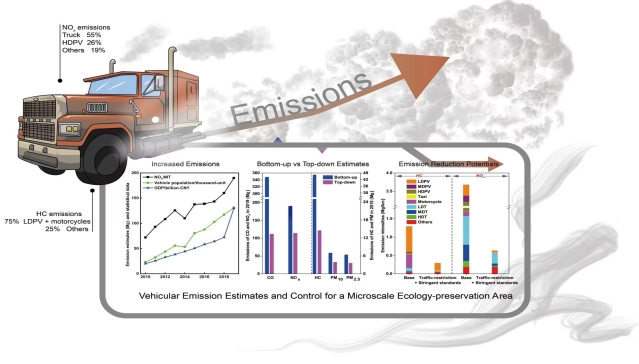
Highlights
On-road vehicle bottom-up emission intensity (EI) was built with a spatial resolution of 10 m × 10 m.
Temporal variations of bottom-up EI showed strong relationship with observations.
Bottom-up EI with traffic-flow data showed superiority to top-down estimate.
Traffic-restriction with stringent standards led to huge emission reduction benefits.
A low emission zone (LEZ) is proposed for a microscale area possessing ecology-preservation nature.
Abstract: The Chishui River Valley is a microscale ecology-preservation area with industrial clusters. The significance of evaluating vehicular emissions has been gradually highlighted with the rapid development of the local transportation and tourism sectors. This study provides the first estimates based on both bottom-up and top-down approaches. The annual total emissions of CO, NOx, hydrocarbons (HC), PM10, and PM2.5 in 2019 were 347.8, 189.6, 46.3, 6.9, and 6.3 Mg, respectively. Trucks contributed the most (55%) to the NOx emissions, followed by heavy-duty passenger vehicles (26%). In contrast, light-duty passenger vehicles and motorcycles generated 75% of the HC emissions. The superior accuracy of highly spatial and temporal bottom-up estimates versus top-down estimates is validated by the similar variation trends of hourly emission intensities and enhanced concentrations relative to background observations for both NOx and CO, with Pearson correlation coefficients between the intensities and concentrations ranging from 0.79 to 0.85. Historical HC emissions peaked in 2013, followed by a sharp decline in 2014 and a continuous rise since then, whereas NOx emissions have kept increasing since 2010. These indicated the necessity and urgency of effective vehicular emission mitigations. Based on scenario analysis, traffic restrictions combined with upgrading the emission standards of admitted vehicles will possess huge emission reduction potentials. Future recommendations about establishing a low emission zone in the valley and supporting policies were introduced.
Keywords: Vehicle; Emission; Bottom-up method; Ecology-preservation; Mitigation; Low emission zone
DOI: 10.1016/j.eehl.2022.09.003